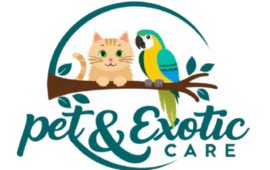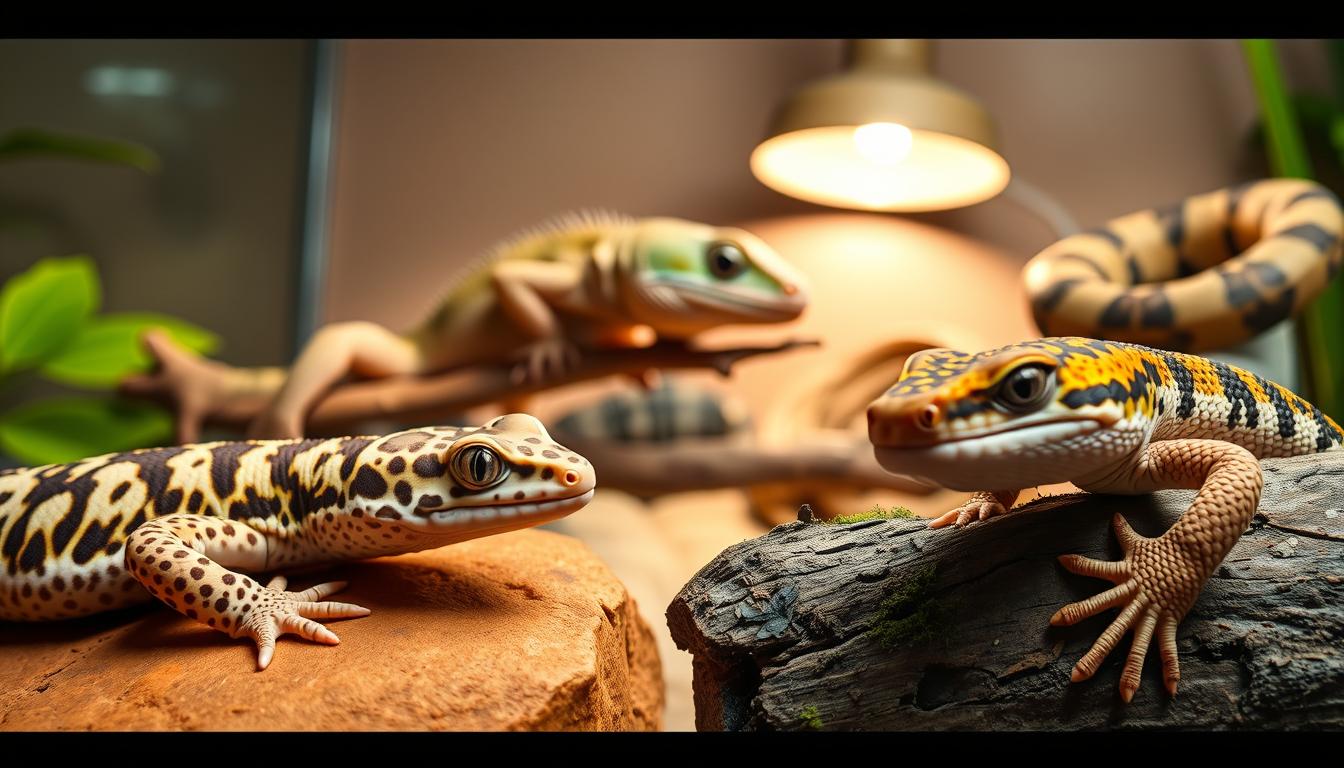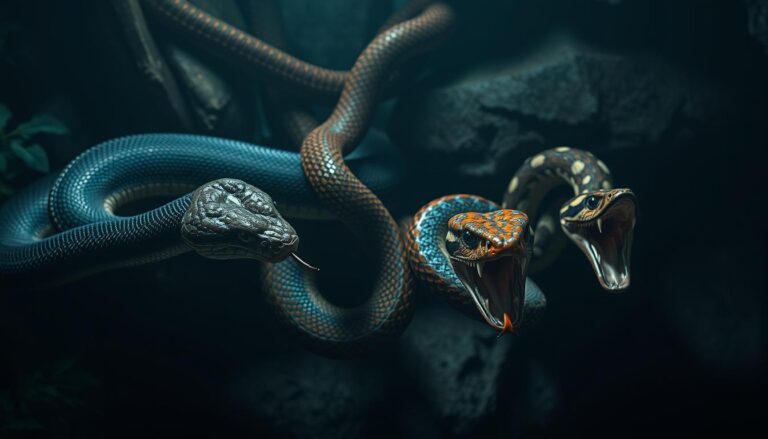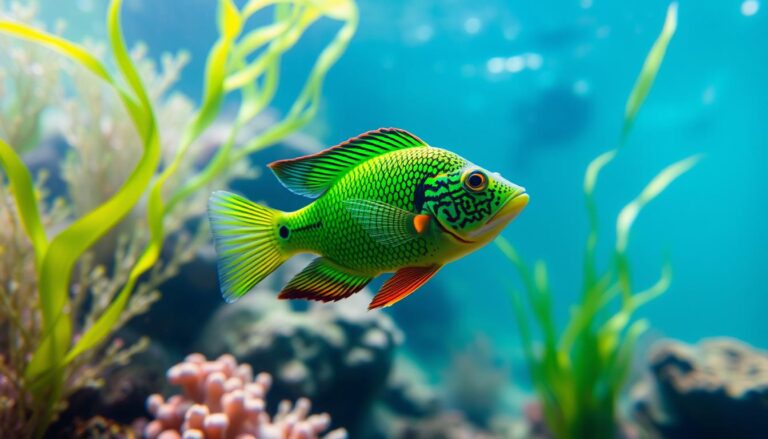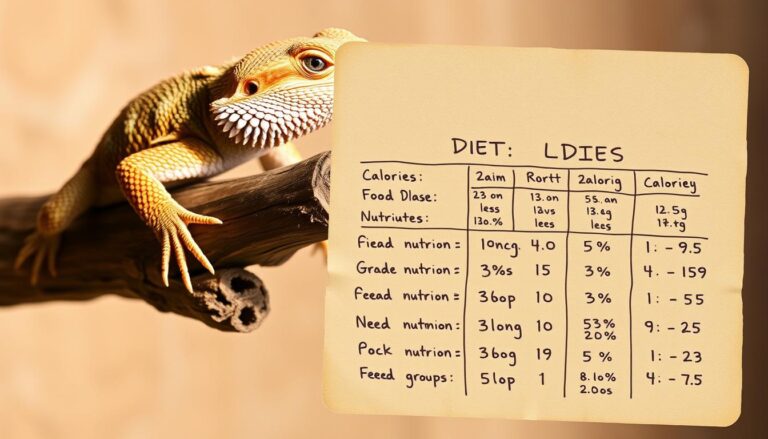Top 5 Low-Maintenance Reptiles for Busy Owners
Can you enjoy the companionship of a pet even with a hectic schedule? Many people assume that having a pet requires a lot of time and attention, but certain reptiles can make great companions for busy owners. These unique pets offer several advantages over traditional pets like cats and dogs, including reduced daily care requirements….
Can you enjoy the companionship of a pet even with a hectic schedule? Many people assume that having a pet requires a lot of time and attention, but certain reptiles can make great companions for busy owners.
These unique pets offer several advantages over traditional pets like cats and dogs, including reduced daily care requirements. Some reptile species have adapted to thrive with minimal human intervention, making them perfect for people with demanding schedules.
Key Takeaways
- Discover the benefits of having reptiles as pets for busy owners.
- Learn about the top 5 low-maintenance reptile species that are ideal for busy lifestyles.
- Understand the importance of proper setup and consistent care for reptile pets.
- Find out how to choose the right reptile that matches your lifestyle and living situation.
- Explore the unique advantages of reptiles as pets compared to traditional pets.
Why Reptiles Make Great Pets for Busy Lifestyles
For individuals with hectic schedules, reptiles offer a unique pet-keeping experience that is both rewarding and low-maintenance. Reptiles are excellent pets, but they have certain requirements that cats and dogs do not. Understanding their unique needs is crucial before adopting.
Reptiles come in different shapes and sizes, and some need more care than others. The primary goal for many potential pet owners is minimal maintenance. Most individuals lack the time and money for a pet with diverse requirements.
Benefits of Reptile Ownership
Reptiles offer several advantages as pets for people with demanding schedules or limited free time. Some of the key benefits include:
- Less frequent feeding requirements due to their cold-blooded nature
- Hypoallergenic qualities, making them suitable for people with allergies to fur or dander
- The ability to thrive with less direct daily interaction while still forming bonds with their owners
- Space efficiency, ideal for apartment dwellers or those with limited room for pets
- Reduced noise factor, as they rarely make disruptive sounds
- Companionship without the time-intensive care routines associated with traditional pets
To illustrate the ease of caring for reptiles, consider the following comparison:
| Pet Type | Feeding Frequency | Space Requirements | Noise Level |
|---|---|---|---|
| Reptiles | Low (Weekly or Bi-Weekly) | Compact (Variable Enclosures) | Quiet |
| Dogs | High (Daily) | Variable (Often Large) | Loud |
| Cats | Medium (Daily) | Medium (Variable Litter Boxes) | Moderate |
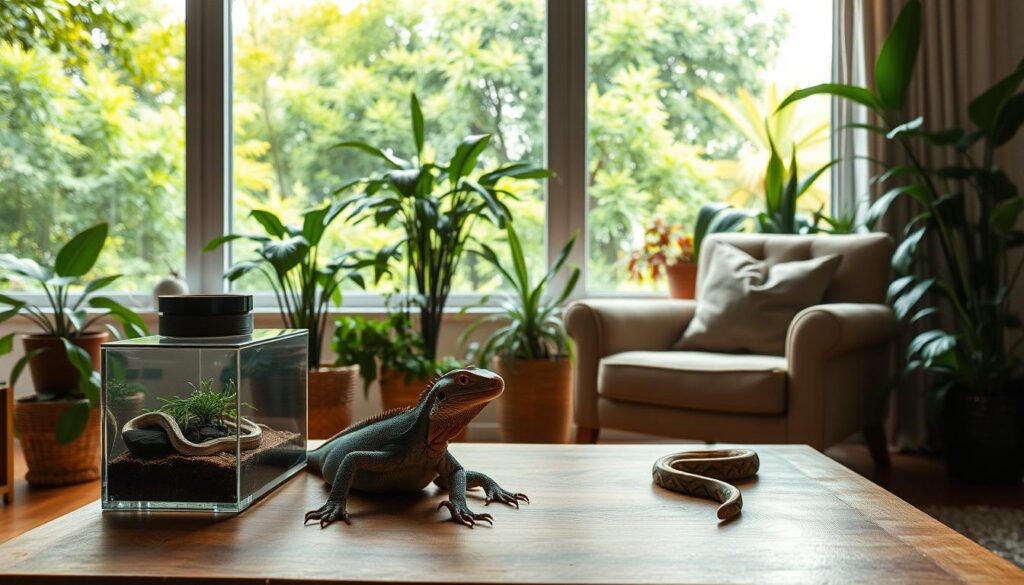
Reptiles make great pets for those who value ease of care and are looking for a best pet that fits their busy lifestyle. With the right easy care practices, owning a reptile can be a highly rewarding experience.
What Makes a Reptile “Low-Maintenance”
The term ‘low-maintenance’ is often used to describe certain reptiles, but what does it really mean in the context of pet care? In essence, a low-maintenance reptile is one that requires fewer resources and less complex care compared to other pets. This makes them ideal for busy owners or those new to reptile care.
Several key factors determine a reptile’s care requirements, including feeding frequency, habitat complexity, and temperature regulation needs. Reptiles that have simpler feeding schedules, less demanding habitat requirements, and more forgiving temperature ranges are generally considered low-maintenance.
A reptile’s natural adaptations in the wild can significantly influence its care needs in captivity. For instance, some reptiles have evolved to survive in harsh conditions with minimal food and water, making them more adaptable to minor fluctuations in their captive environment.
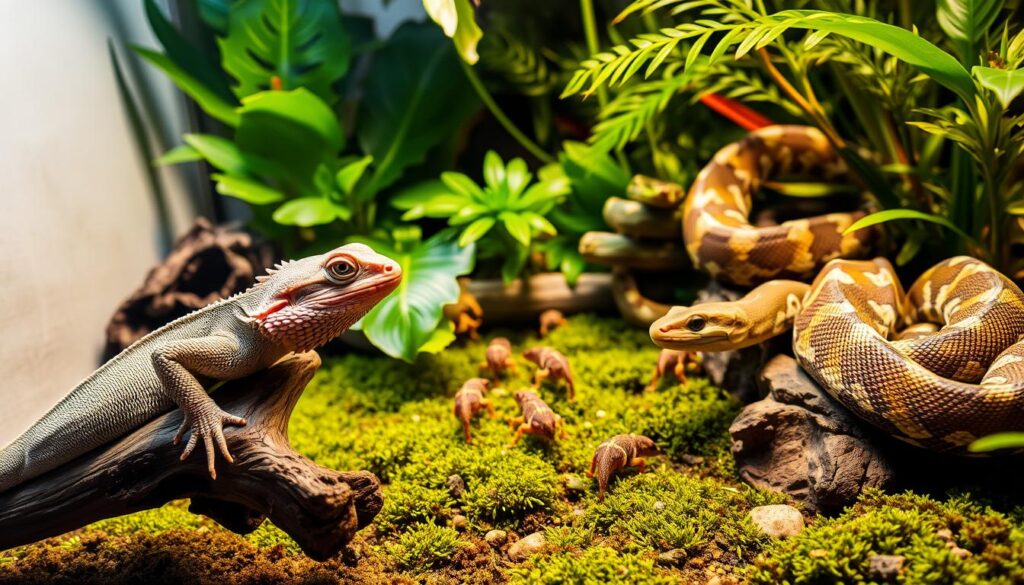
The initial setup of a reptile’s habitat is crucial. A well-designed enclosure can significantly reduce daily maintenance tasks. This includes setting up appropriate heating, lighting, and humidity levels that mimic the reptile’s natural habitat, thereby reducing the need for constant adjustments.
Certain reptile species have evolved to be more resilient to changes in their environment, making them more suitable for owners who may not be able to monitor their pets’ conditions constantly. However, it’s essential to remember that even low-maintenance reptiles require consistent attention to their basic needs, such as clean water, appropriate temperatures, and proper nutrition.
A reptile’s size, lifespan, and growth rate also play significant roles in determining its overall maintenance requirements. Larger reptiles or those with longer lifespans may require more substantial initial investments in their habitat and care, while those with rapid growth rates may need more frequent dietary adjustments.
| Reptile Characteristic | Impact on Maintenance | Examples |
|---|---|---|
| Feeding Frequency | Less frequent feeding reduces daily maintenance. | Leopard Geckos, Corn Snakes |
| Habitat Complexity | Simpler habitats require less upkeep and are easier to manage. | Bearded Dragons, Ball Pythons |
| Temperature Regulation | Reptiles with broader temperature tolerances are easier to care for. | Crested Geckos, Leopard Geckos |
Understanding these factors can help potential owners choose a reptile that fits their lifestyle and experience level, ensuring a rewarding pet-keeping experience for both the owner and the reptile.
What to Consider Before Getting an Easy Reptile Pet

Before bringing home a new reptile pet, it’s crucial to consider several key factors that will ensure a happy and healthy companion. Reptiles and amphibians need very specific care and attention, so it’s essential to do your research and understand their requirements.
Space and Housing Requirements
One of the primary considerations is the space and housing requirements for your reptile. Different species have varying needs when it comes to enclosure size and setup. For example, bearded dragons require a spacious enclosure with adequate ventilation, while geckos can thrive in smaller, well-ventilated spaces.
Understanding the size and type of enclosure your reptile needs is crucial for providing the right environment. Research the specific housing requirements for your chosen species to ensure you can provide the necessary space.
Time Commitment Expectations
Caring for a reptile is a time-consuming commitment. You need to consider the time required for feeding, cleaning, and monitoring the health of your pet. Some reptiles, like snakes, may have simpler feeding schedules, while others, like bearded dragons, require a varied diet and regular handling.
It’s essential to understand the time commitment involved in caring for your reptile and ensure that you can provide the necessary attention and care.
Budget Considerations
Reptile ownership comes with various expenses, including the initial setup costs, food, substrate replacement, and veterinary care. It’s crucial to examine the complete financial picture of reptile ownership beyond just the initial purchase price.
- Understand the startup costs for proper habitat setup, which often represents the largest expense in reptile keeping.
- Learn about ongoing expenses including food, substrate replacement, electricity for heating/lighting, and veterinary care.
- Compare the relative costs of different reptile species, from budget-friendly options to more expensive specialist species.
- Consider the relationship between a reptile’s size and its long-term care costs, as larger species typically require more resources.
- Understand how dietary needs affect budget, from inexpensive vegetarian diets to more costly insect or rodent-based feeding programs.
- Recognize potential unexpected costs such as replacement equipment, habitat upgrades as animals grow, and emergency veterinary care.
By understanding these costs, you can make an informed decision about whether a reptile is the right pet for you.
Bearded Dragons: The Friendly Desert Dwellers
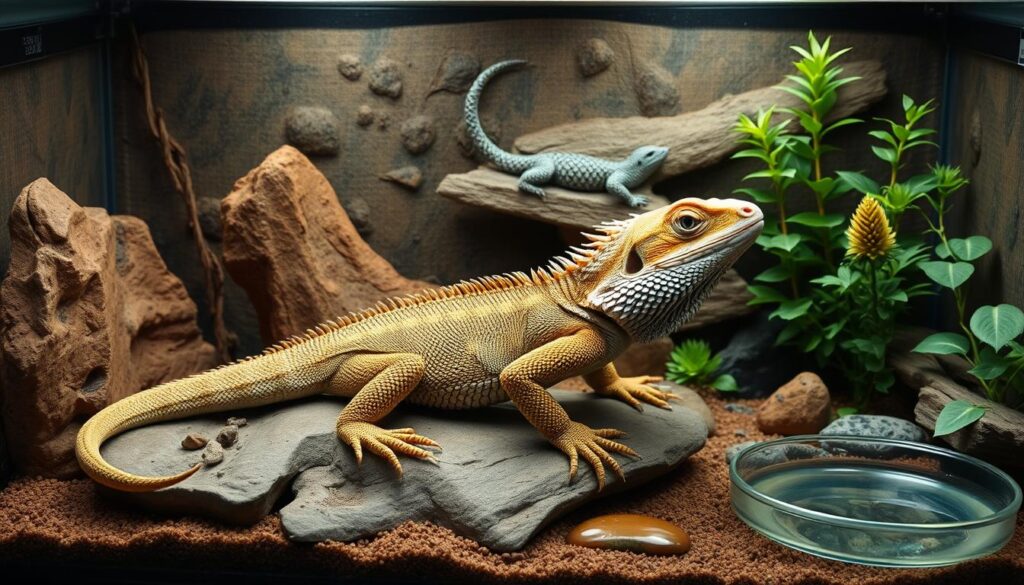
For those new to reptile ownership, bearded dragons offer an ideal introduction with their calm demeanor and straightforward care requirements. Native to Australia, these desert dwellers are adapted to arid environments, tropical savannas, heathlands, and woodlands, making them a great choice for enthusiasts.
Personality and Handling
Bearded dragons are known for their friendly and docile nature, making them an excellent choice for beginners. They are relatively small, reaching about 18-24 inches in length, including their tail. Handling bearded dragons regularly can help them become tame and enjoy human interaction.
Housing and Habitat Setup
Creating a suitable habitat for bearded dragons involves replicating their natural environment. A spacious terrarium with a secure top is essential, as bearded dragons are skilled climbers. The enclosure should have a basking area, a cooler zone, and adequate ventilation to maintain a healthy environment.
Diet and Feeding Schedule
Bearded dragons are omnivores, requiring a balanced diet of vegetables, fruits, and proteins. A mix of leafy greens, vegetables, and occasional fruits should be provided daily. Protein sources, such as crickets and mealworms, should be included in their diet, especially during the juvenile stage.
Temperature and Lighting Needs
Maintaining the right temperature and lighting is crucial for the health of bearded dragons. The ideal temperature gradient includes a basking area of 100-110°F, a mid-temperature zone of 80-99°F, and a cool end of 71-78°F. Nighttime temperatures should be between 68-71°F. Proper temperature management is vital for their metabolic processes.
Key considerations for temperature and lighting include:
– Understanding the specific temperature requirements that make bearded dragons manageable despite their desert origins.
– Creating a proper temperature gradient that allows dragons to self-regulate their body temperature.
– Using modern heating equipment that can be automated to maintain proper temperatures with minimal monitoring.
– Recognizing the critical role of UVB lighting in calcium metabolism and how proper lighting prevents common health issues.
– Maintaining appropriate nighttime temperatures without constant adjustment.
– Monitoring humidity levels, which should be between 30-40%, a relatively manageable range compared to many tropical reptile species.
Leopard Geckos: The Perfect Starter Reptile
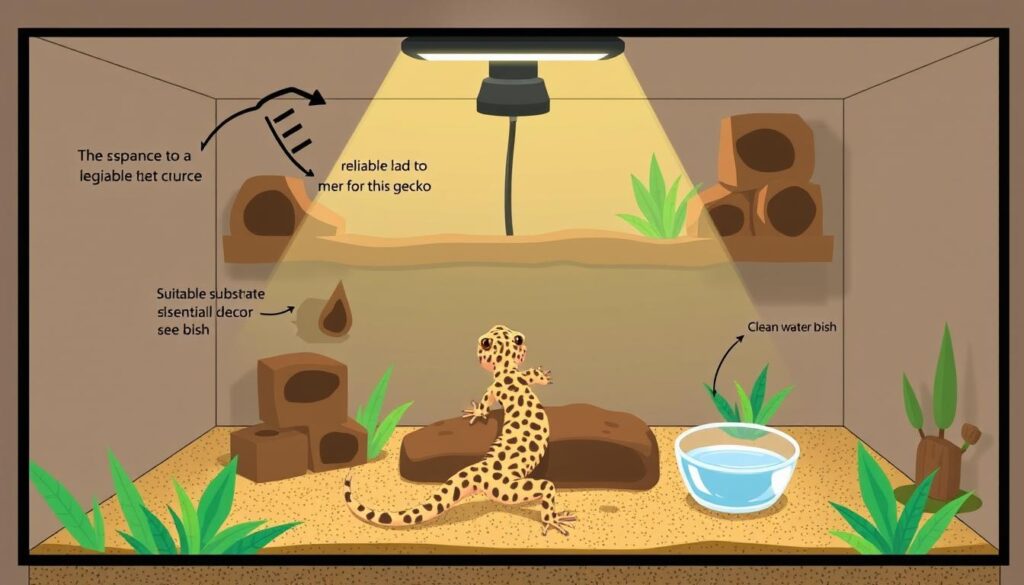
For those new to reptile ownership, leopard geckos stand out as an ideal starting point due to their calm nature and straightforward care requirements. These small, gentle creatures are not only easy to handle but also offer a fascinating insight into the world of reptiles.
Temperament and Socialization
Leopard geckos are known for their docile temperament, making them an excellent choice for beginners. They are relatively small, typically growing to about 8-10 inches in length, and have a calm demeanor that makes handling them a pleasure. While they don’t require extensive socialization, gentle and regular handling can help them become more tame and trusting.
Enclosure Requirements
When it comes to housing leopard geckos, a well-ventilated, secure enclosure is essential. A 12x12x18 inch terrarium is a good size for a single adult gecko, providing ample space for movement and the creation of a temperature gradient. The enclosure should include hiding places, such as rocks or small caves, to help the gecko feel secure.
Feeding Habits and Diet
Leopard geckos are insectivores, feeding on a diet rich in live insects such as crickets, mealworms, and waxworms. A varied diet is crucial to ensure they receive a broad spectrum of nutrients. It’s recommended to gut-load the insects before feeding them to the gecko to enhance their nutritional value. A feeding schedule of 2-3 times a week is typically adequate for adults.
Heating and Humidity Considerations
Creating the right environment for leopard geckos involves managing temperature and humidity levels. The basking area should be around 86-90°F, with a warm hide at 82-86°F and a cool end at 75-78°F. At night, the temperature can drop to a minimum of 64°F. Humidity levels should be maintained between 30-40%. Using a heat mat and a thermometer can help achieve and maintain the desired temperature gradient without the need for complex lighting setups.
One of the advantages of keeping leopard geckos is their adaptability to a relatively simple heating and lighting setup. Their nocturnal nature means they don’t require UVB lighting, simplifying their care. By understanding and meeting their temperature and humidity needs, you can ensure your leopard gecko leads a healthy and happy life.
Crested Geckos: Low-Maintenance Climbers
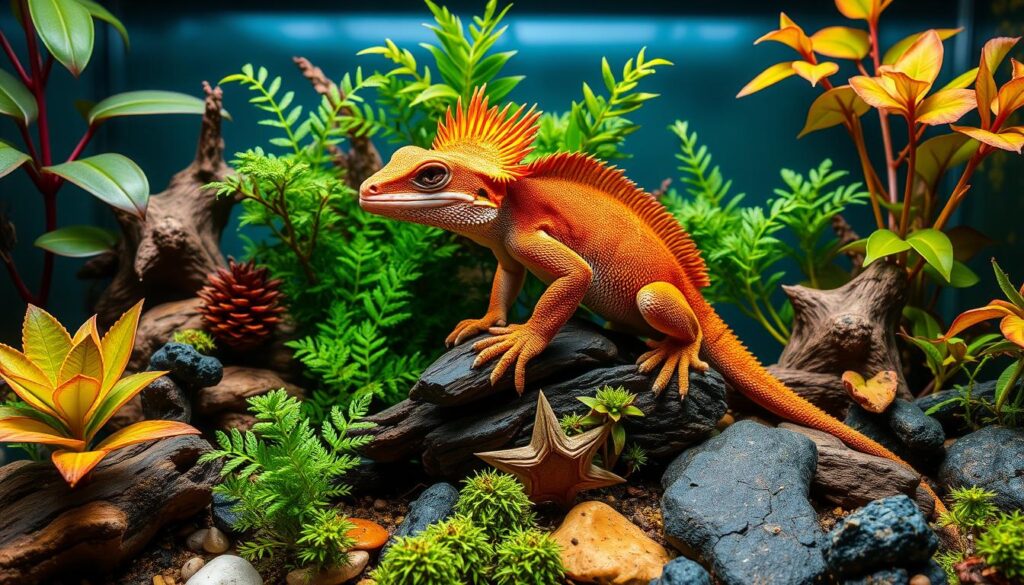
For those looking for a pet that’s easy to care for, crested geckos are an excellent choice. They are known for their gentle nature and straightforward care requirements, making them ideal for both beginners and experienced reptile enthusiasts.
Personality Traits and Handling
Crested geckos are generally calm and docile, allowing for gentle handling. They are nocturnal, so they are most active at night, but they can still be handled during the day if done carefully.
Handling Tips: Start with short handling sessions and gradually increase the time as the gecko becomes more comfortable.
Vertical Housing Needs
Crested geckos are arboreal, meaning they love to climb. Therefore, they require a vertically oriented enclosure with plenty of branches and foliage.
Enclosure Requirements: A 20-gallon tall terrarium is recommended, with a secure top to prevent escape.
Simplified Diet Options
Crested geckos have a relatively simple diet. They can be fed a commercial gecko diet, supplemented with live insects like crickets and dubia roaches.
Feeding Schedule: Feed adults a balanced diet 2-3 times a week, adjusting the amount based on their weight and overall health.
Temperature and Moisture Requirements
Crested geckos require a moderate temperature range. They need a temperature gradient in their enclosure, with a basking area around 74-76°F and a cooler end around 70-75°F during the day. At night, the temperature can drop to 65-72°F.
Humidity levels should be maintained between 60-80%. Regular misting of the enclosure is necessary to achieve this.
- Learn about the moderate temperature requirements that often align with human comfort levels, reducing heating costs.
- Understand how their natural adaptations to New Caledonian forests result in temperature needs that are less extreme than desert species.
- Discover how their temperature requirements often mean less specialized equipment is needed compared to other reptiles.
- Explore how their higher humidity needs can actually be maintained with simple misting routines rather than complex systems.
- Understand the importance of proper moisture cycles that mimic natural conditions while preventing health issues.
- Learn about the modest nighttime temperature drop that’s easier to maintain than strict temperature requirements.
- Discover how modern misting equipment can be automated to maintain proper humidity with minimal daily intervention.
Corn Snakes: Colorful and Calm Companions
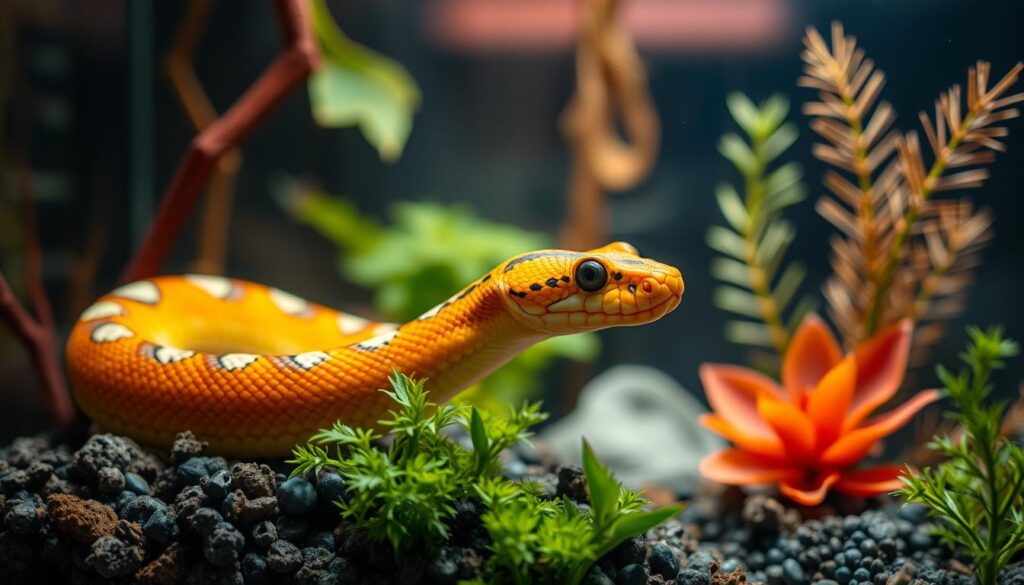
For those interested in a calm and visually appealing pet snake, corn snakes are an excellent option. They are known for their docile nature and vibrant color patterns, making them a popular choice among reptile enthusiasts.
Temperament and Behavior
Corn snakes are renowned for their calm demeanor, which makes them an ideal pet for both beginners and experienced snake owners. They are non-venomous constrictors that are native to North America, found in various habitats ranging from marshes to woodlands.
Enclosure Setup and Size
When it comes to housing corn snakes, a well-ventilated, secure enclosure is essential. A 20-gallon tank is a good size for an adult corn snake, providing enough space for movement and thermoregulation.
Feeding Schedule and Prey Types
Corn snakes are carnivores and feed on mice or rats. A typical feeding schedule involves offering a prey item every 7-10 days, depending on the snake’s age and size. The prey should be slightly larger than the snake’s girth to ensure proper nutrition. (100 words)
Temperature Gradient and Hiding Spots
Maintaining an appropriate temperature gradient is crucial for the health of corn snakes. The basking area should be around 84-86°F, with a day temperature of 70-75°F and a night temperature of 60-70°F. Providing hiding spots at both the warm and cool ends of the enclosure is essential for thermoregulation. Modern heating equipment can be automated to maintain proper temperatures with minimal monitoring.
Some key benefits of keeping corn snakes include:
– Moderate temperature requirements that make them easier to maintain than many tropical species.
– The ability to create an effective temperature gradient with simple equipment that requires minimal adjustment.
– The importance of proper hide boxes at both warm and cool ends of the enclosure for thermoregulation.
– Their adaptability to various environments in the wild, which translates to forgiveness of minor temperature fluctuations.
– Modest humidity requirements that are less demanding than many tropical reptile species.
– The natural day/night temperature cycle and how to maintain appropriate nighttime temperatures without constant adjustment.
Ball Pythons: Docile Snake Companions
The ball python’s reputation as a calm and manageable snake has made it a favorite among reptile keepers. Originating from central and western Africa, these snakes are adapted to living on the ground in open forests, savannas, and grasslands, and sometimes even in water.
Handling and Temperament
Ball pythons are renowned for their docile nature. They are non-venomous snakes that rarely bite, making them an excellent choice for both beginners and experienced reptile enthusiasts. Handling them regularly can help build trust and ensure they remain calm.
Housing Requirements
When it comes to housing ball pythons, it’s essential to provide a secure, escape-proof enclosure. A well-ventilated tank with adequate space for movement is crucial. The enclosure should mimic their natural habitat as closely as possible.
Feeding Schedule and Prey Types
Ball pythons are carnivores and feed on mice or rats. The size of the prey should be appropriate for the snake’s age and size. A consistent feeding schedule is vital for their health and growth.
Heat and Humidity Management
Managing the temperature and humidity levels is critical for the health of ball pythons. The ideal temperature gradient should range from 75-78°F at night to 78-80°F during the day, with a basking area of 90-94°F. Maintaining a humidity level of 50-60% is also crucial, especially during shedding. Proper water availability is necessary for hydration and maintaining the right humidity.
- Learn about the specific temperature and humidity requirements that make ball pythons manageable despite their tropical origins.
- Understand how to create an effective temperature gradient with simple equipment that requires minimal adjustment.
- Discover the importance of proper humidity levels for successful shedding and respiratory health in snakes.
- Explore how modern humidity control methods can simplify what was traditionally a challenging aspect of ball python reptile care.
By understanding and implementing these care requirements, ball python owners can ensure their pets lead healthy, happy lives. Proper care and attention to detail can make a significant difference in the well-being of these docile snakes.
Essential Equipment for Low-Maintenance Reptiles
The right equipment plays a vital role in maintaining the health and happiness of your reptile. To ensure you’re providing the best possible care, it’s essential to understand the basic supplies needed for their habitat, heating and lighting, and feeding and hydration.
Basic Habitat Supplies
Creating a suitable environment for your reptile starts with the right habitat supplies. This includes a well-ventilated enclosure that is appropriately sized for your pet. A secure, escape-proof lid is also crucial. Inside the enclosure, you’ll need substrate, such as calcium sand or reptile carpet, and decorations like rocks, plants, or branches to provide hiding spots and climbing opportunities.
Heating and Lighting Equipment
Reptiles require specific temperature ranges and lighting conditions to thrive. Heating elements like heat mats, heat lamps, or ceramic heat emitters can help maintain the desired temperature. It’s also important to use a thermometer to monitor the temperature and a thermostat to control the heating elements. For lighting, many reptiles need UVB light to synthesize vitamin D3, so a high-quality UVB light source is essential.
Feeding and Hydration Tools
Feeding your reptile a balanced diet is critical for their health. For many species, this includes live invertebrates like crickets, which should be gut-loaded and dusted with calcium and vitamin supplements. Feeding tongs or forceps can make prey delivery safer and more controlled. Food and water dishes designed specifically for reptiles can reduce spillage and contamination. For species that require higher humidity, automated misting systems can be beneficial. Ensuring access to fresh water daily is also vital.
| Equipment | Purpose | Examples |
|---|---|---|
| Heating Elements | Maintain optimal temperature | Heat mats, heat lamps, ceramic heat emitters |
| Lighting | Provide UVB light for vitamin D3 synthesis | UVB light bulbs, LED lights |
| Feeding Tools | Safe and controlled prey delivery | Feeding tongs, forceps |
| Water and Food Dishes | Reduce spillage and contamination | Shallow dishes, water bowls |
By investing in the right equipment, you can create a thriving environment for your low-maintenance reptile, ensuring they lead a happy and healthy life.
Common Mistakes to Avoid with Easy Reptile Pets
Reptiles can make great pets, but only if their owners are aware of and avoid certain common errors. Many new owners are drawn to reptiles because they are perceived as low-maintenance pets. However, this perception can lead to neglect of the specific needs of these animals.
Inadequate Research Before Purchase
One of the most significant mistakes prospective reptile owners make is not conducting thorough research before bringing a pet home. Understanding the specific dietary, environmental, and social needs of a reptile is crucial for its well-being.
For instance, different reptiles have varying requirements for temperature, humidity, and lighting. Failing to provide the correct environment can lead to health issues. It’s essential to research the specific needs of the reptile you’re interested in keeping.
Improper Temperature Management
Temperature management is critical for reptiles, as they are ectothermic, meaning they regulate their body temperature using external sources. Providing the wrong temperature range can lead to metabolic problems, stress, and even death.
A proper temperature gradient should be established in the enclosure, allowing the reptile to thermoregulate effectively. This involves using heat sources like lamps or heat mats and ensuring there’s a cooler area for the reptile to retreat to when needed.
Neglecting Regular Health Checks
Regular health checks are vital for maintaining the health of your reptile. Many reptile illnesses are subtle and can be easily overlooked by inexperienced keepers. Monitoring your reptile’s weight, appetite, and overall condition can help identify potential health issues early.
| Common Health Issues | Signs to Look Out For | Preventive Measures |
|---|---|---|
| Metabolic Bone Disease | Lethargy, softening of bones, swelling | Proper UVB lighting, calcium supplementation |
| Respiratory Infections | Wheezing, lethargy, loss of appetite | Maintaining proper temperature and humidity, avoiding drafts |
| Parasites | Weight loss, lethargy, skin lesions | Regular fecal exams, quarantining new animals |
Establishing a relationship with an exotic veterinarian before emergencies arise can be invaluable. They can provide guidance on proper care and help identify health issues early on.
Conclusion: Finding Your Perfect Low-Maintenance Reptile Companion
As we conclude our journey through the top low-maintenance reptiles for busy owners, it’s essential to reflect on the key factors that will lead you to your ideal pet. Selecting a reptile that fits your lifestyle is crucial for both you and your pet’s happiness.
Understanding Your Commitment is vital. Reptiles, even those considered low-maintenance, require a long-term commitment to care. Assessing your available time, space, and comfort level with various care requirements will help you make an informed decision.
The rewards of reptile keeping are numerous. Not only do these fascinating creatures provide companionship, but they also offer a unique opportunity to learn about and connect with nature. By choosing a species that aligns with your lifestyle and preferences, you’ll be more likely to enjoy a fulfilling long-term relationship with your reptile companion.
To summarize, when selecting a low-maintenance reptile, consider the following key points:
- Assess your available time and space to ensure it matches the needs of your chosen reptile.
- Understand the specific care requirements of your reptile, including diet, habitat, and health checks.
- Choose a species that aligns with your long-term commitment capabilities.
- Consider the personality and activity level of the reptile to ensure it matches your preferences.
- Recognize that even “low-maintenance” reptiles require consistent care and attention to thrive.
By carefully considering these factors and starting with an appropriate beginner species, you can set yourself up for success and enjoy the many rewards that come with reptile keeping. Whether you’re drawn to the friendly bearded dragon, the calm leopard gecko, or another species, the right reptile companion can bring joy and fascination into your life.
Ultimately, the best reptile pet is one that fits seamlessly into your lifestyle, providing a mutually beneficial and enjoyable experience for both you and your pet.
